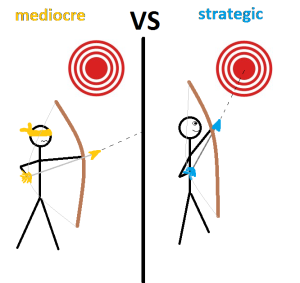PRSA attempts to Define our industry
 Being a relative new-comer to the Public Relations industry, I find myself in a situation familiar to most veteran PR professionals: unable to explain exactly what I do.
Being a relative new-comer to the Public Relations industry, I find myself in a situation familiar to most veteran PR professionals: unable to explain exactly what I do.
Most of my Gen-Y friends see what I do as a sub-set of advertising. Others view me simply as a corporate writer, while a few think I just “play” on Facebook and Twitter all day.
All these answers have some truth to them, but as someone who makes a living influencing perception I feel pretty stupid not being able to give people a good definition for PR. Which is why I’m excited about what the Public Relations Society of America (PRSA) is doing for the next couple weeks with their “Public Relations Defined” initiative.
I won’t got into the details of the initiative here (you can catch good coverage of the why & how from the NY Times, Forbes or PRSA themselves), but I did want to share my definition.
As PRSA crowd-sources definitions, it will be interesting to see how pros, students and academics in the field collectively answer the question: “what do you do?”
Public Relations establishes and strengthens strategic relationships through ethical, honest and transparent actions
with/for key stakeholders of an organization
to establish mutually beneficial rapport and goodwill among these stakeholders
for purposes that support business objectives by arming stakeholders with the truth.
There’s room to expand on this definition, but knowing that PRSA has already collected over 400 responses in two days, I’m happy about my drop in the bucket.
What would you add or subtract from this? Anything blatant I missed? Small tweaks for improvement?
OR, fill out the PRSA form for yourself.
Unfortunately, my definition comes far from a concrete explanation that sufficiently communicates what I do. Here’s to hoping PRSA can bring it down to that level. 😀
pic courtesy of plrinternetmarketing.com
TFMCNB – 11/5/11 – Mediocre PR
In case you missed the first installment of “Thoughts From My Chinese Notebook,” these mini-posts stem from good ol’ fashioned pen & paper journaling I’ve done in a small 4×6-inch book. Short. Sweet. To the Point.
There’re plenty of opportunities to do mediocre PR.
Nothing against this; serving clients with the basics is a bountiful low-hanging fruit, and in the end agencies doing press releases on-demand are contributing to the marketing mix for organizations at the same time they’re adding credibility to the PR industry as a whole.
(BTW, “mediocre PR” doesn’t include the likes of Kim Kardashian – whatever she’s doing doesn’t qualify as Public Relations and I think most pros agree).
The difference I’m delineating is between pigeon hole PR and true strategically applied communications.
There’s responding to a request for publicity by engaging in media relations and then there’s authoring a researched communications plan that supports business objectives. Oftentimes they require the same skillset, just applied in a different manner.
Think of it this way:
Being asked to write a press release with no information outside of the subject matter is similar to shooting blindly. No matter how straight and swiftly your arrow (the press release) flies, there’s no promise it’s aimed at the right target.
Strategy, on the other hand, takes into account the surroundings and accuracy of every tactic as well as the tactics themselves (a press release in this example). This includes business climate, other marketing/PR/Advertising activities and countless other factors.
Strategy enables success by identifying the right target. Strategy empowers PR by removing the mediocrity and tying your communication objectives back to a business need. Strategy lets you see.
The plight of the Infographic
Like others, I’ve been lured to crappy content because of the “i” word – and I’m not talking about one of the glorious inventions from Apple.
The term “infographic” has become so over-used it’s earned its place on buzz-word bingo cards across business. (In other news, synergy just fell out of circulation on those cards, so feel free to use that again without shame!)
The good news is nothing online is impervious to a snarky post, and with a little leverage maybe some communicators will hear my rant. I’ve heard they respond best to sarcasm and hyperbole so I’ll do my best. It’s more fun to write anyway – the same kind of fun I find when I turn my bar-room napkin notes into a flow-chart nightmare hoping to confuse the audience into thinking I’m smart. #WorksEveryTime

Feast of Knowledge on Board.
Plus reading normal copy is boring. If it’s not served up on an image of the Mayflower to denote that it’s serving my mind a Thanksgiving feast-full of knowledge, I’m not interested.
Face it. We’ve been overstimulated to the point that black & white verbiage is passé. Every clever idea, concept, joke, list, post or proposal is dull without a visual representation to accompany it. Hopefully with some random wording, arrows and glitter to catch my attention.
To be fair, an infographic is a great way to convey complicated models or less-than-concrete concepts in a concise, engaging manner. But the types of diagrams we’re calling “infographics” these days are ridiculous. Slapping your top-ten list on a stock-image of hedgehogs isn’t cute, it’s distracting and adds little value.
A good rule of thumb: If the content isn’t good to begin with, dressing it up with graphics doesn’t help. It’s the idea that counts.
This isn’t the case all the time, and there’s plenty of great infographics out there, but they only serve their purpose when the graphics, data and text work together to tell the message. Clarity is key; communication should drive an outcome.
In case you’re feeling the infographic itch, remember my snark and ask yourself the three questions I use – and none of them deal with the colors, fonts or clip art I’m going to use. They speak to the basics:
1) Who am I talking to? (audience)
2) What’s the essence of what’s being communicate? (the simplest form)
3) What’s the best way to communicate this? (channel)
If the answer to number three is some combination of charts and text, I’ll pursue a concept for an infographic. It’s helpful for the simplicity demanded in question 2, and can tie complex ideas together in a way that’s conducive to self-learning – something we all do constantly via the ‘net.
And in case you’re disappointed I didn’t create an (unnecessary) infographic for this post, I’ve listed a few sites below with more good examples of when to use this specific communication device:
http://www.coolinfographics.com/
http://www.good.is/infographics
http://slodive.com/design/showcase-infographic-designs/
…as well as some awful ones for all y’haters:
http://terribleinfographics.tumblr.com/
http://infosthetics.com/archives/2009/12/most_ugly_useless_infographic_the_winners.html
http://www.b2bbloggers.com/blog/6-mistakes-b2b-marketers-make-with-infographics/
Weaving your networking safety net
Recently finding myself at the onset of a job search, I’ve felt a little like I was falling. Anyone who’s been laid off or between jobs can relate to this unsupported feeling and references to “where I will land” are bountiful. Luckily for me, I’ve spent the last few years weaving a network that’s softening the fall. 
The power of networking isn’t a secret. Whether it’s in person or online, connecting to professionals whose experience overlaps yours is important to professional development. No one gets ahead by working in a box by themselves.
My approach in northeast Ohio was to diversify and form lasting professional relationships based on mutual respect. Granted my last name was an asset in this region for opening doors, I made sure to branch outside former students and PR connections of my father.
I’ve listed some basic tips below. Even if you don’t expect to join the ranks of the unemployed, these pointers can help you improve at your current position and open doors for career advancement down the road.
Follow your interests. I participated in a litany of industry organizations from IABC to SM clubs, PRSA and AAF. All introduced me to interesting people I’ve stayed in contact with who work in the PR field or something closely related. Pursuing these adjacent specifications gave me an education in each as well as where PR fits into the mix.
Be politely persistent. People are busy but generally willing to meet with you. People like helping people, and in the PR field are happy to add another card to their rolodex. Reach out politely to set up an informal meeting and follow up with grace – you’ll be surprised by the warm reception.
 Get uncomfortable. Remember you’re looking to weave a network and not braid a rope. Strengthening existing connections is a part of this, but too often people stay in their safe zone. Branch out. To coworkers, industry notables and strangers at networking events – you never know who can help you, or vice versa. It doesn’t take long to determine if there’s not a fit, and the anxiety of awkwardness fades quickly, I promise.
Get uncomfortable. Remember you’re looking to weave a network and not braid a rope. Strengthening existing connections is a part of this, but too often people stay in their safe zone. Branch out. To coworkers, industry notables and strangers at networking events – you never know who can help you, or vice versa. It doesn’t take long to determine if there’s not a fit, and the anxiety of awkwardness fades quickly, I promise.
Stay connected. When you’ve made a connection that’s genuine and mutual in some fashion, don’t let it dwindle. If the last two weeks has taught me anything, it’s that I’m glad I’ve maintained my network no matter how busy I was at the office. It’s not that hard, so quit saying you don’t have time. If a lunch or happy hour doesn’t fit into your calendar, a phone call, email, tweet or LinkedIn note can keep a connection fresh and show people you care.
This list could go on for days, but I’ve just listed a few. What do you think? What did I miss?
pics: branckruptcy.wordpress, shakerworkshops.com, nzetc.org
Thoughts from my Chinese Notebook – 10/20/11
 I thought Steele Headed could use a regularly featured short post. This Chinese notebook Steve Ripple brought from his two-year adventure in Guang Zhou is just the ticket. Hope you enjoy what I can fit in two pages or less.
I thought Steele Headed could use a regularly featured short post. This Chinese notebook Steve Ripple brought from his two-year adventure in Guang Zhou is just the ticket. Hope you enjoy what I can fit in two pages or less.
I lost my job 36 hours ago. Corporate restructuring is the formal term, but my past employer made the tough decision to eliminate my position to support their strategic objectives. I understand the decision and am looking forward to my opportunities for the future. I’m thankful for all I’ve learned in the last three years and cannot thank my managers, mentors, colleagues and friends at the company enough. I wish them the best of luck and will be eager to see their success at the end of the tunnel.
As for me, I get the prospect of new opportunities. A chance to change my career, my location, my life.
Dream seeds. I’ve planted them for the last few years and it’s time to sow.
I’ve long known I wanted to work for an agency doing public relations. My dreams are more vivid, but the general vision is what counts: working alongside other business-minded people who use strategic communication to support their clients.
I’m ready. And able. And as I heard earlier tonight, “tenacious.” Though I prefer to think of myself as enthusiastically persistent.

